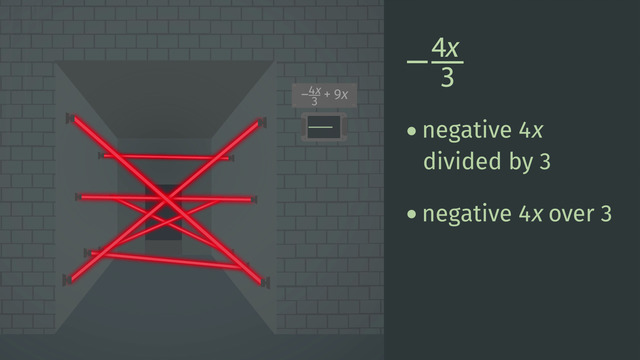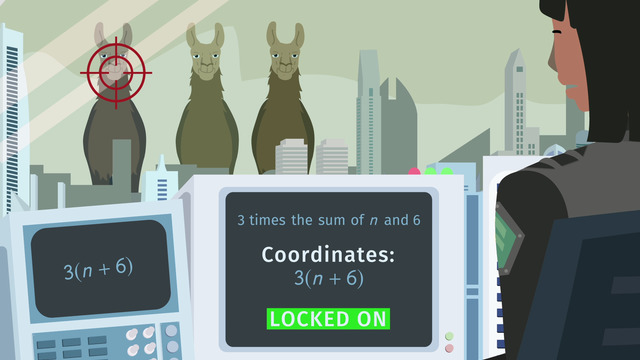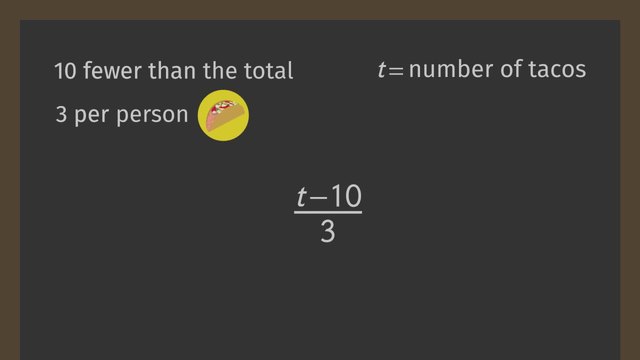How to Read Basic Expressions


Basics on the topic How to Read Basic Expressions
Numerical or arithmetic expressions are the first mathematical sentences one encounters in grade school. We understand operations written in number form and can read them orally. But what if symbols start replacing numbers to represent unknown quantities? We need to know then how to read these kinds of basic expressions as well. In expressions, letters are used to represent quantities and can also be read as such. We then know how to read every element of an expression, so we just have to be mindful of these three basic rules or guidelines in reading basic expressions: read from left to right, pay attention to positive and negative signs, and, when reading fractions, read from top to bottom (numerator first over the denominator). The ability to read basic expressions is a good start to better understand, recognize, and write more complicated expressions, gaining more fluency in the language of mathematics. Learn more about reading basic expressions by helping Lucky escape from hacker prison. Common Core Reference: CCSS.MATH.CONTENT.6.EE.A.2
Transcript How to Read Basic Expressions
Meet Lucky. While on a mission, a careless mistake led to his capture by a rival hacker. I know, I know, Lucky's not lucky. Luckily for Lucky, the rival hackers kinda forgot to lock the door. Lucky takes a quick peek around and, spotting no guards, makes a run for the exit. However, this dusty labyrinth is lousy with booby traps. The way out can be reached by correctly reading the expression above each door. To find the one and only escape route, Lucky must know how to read basic math expressions.
Reading basic math expressions
Above the first door are some spikes. Yikes! Lucky had better read this correctly or else. The expression looks like this: Although there are different ways to read multiplication problems, sometimes it matters if the multiplication sign is written in the expression. In this example, since the multiplication sign is written, it's preferable to read the expression as 'two times y'. But, if you have it written like this: then you can simply read it as '2y'. Since the multiplication sign is in the expression, Lucky reads the expression as '2 times y', avoids the booby trap and moves on. Beware of alligators? There must be a trap door somewhere. Lucky's gotta be careful! Division problems, much like multiplication problems, are able to be read in a few different ways. For example, this can be read in one of three ways:
'x' divided by 2 'x' over 2 or half of 'x'.
Lucky confidently reads the equation as 'x' over 2. The door opened! Thankfully, it wasn't the trap door. Lucky doesn't want to become alligator food. Lucky was able to pass through the first few doors with no problems. But there's one door remaining. It's the toughest one yet!
Positive expressions are pretty straightforward, but what if the first term is negative? Lucky can see freedom! And a web of lasers in the hallway - no worries! Math expressions, just like English, are read left-to-right. So, we start with the fraction. The fraction is negative, so we must state this first. Then, we have to read the numerator before the denominator. Remember, it's division, so you get to choose how you read it!
negative 4x divided by 3 or negative 4x over 3
The next operater from left to right is an addition sign. The term that follows can be read as 9x. Putting this all together, Lucky enunciates each word - negative 4x over 3 plus 9x.
When reading basic math expressions, it's important to remember to read from left to right, pay attention to positive and negative, and read fractions from top to bottom.
Back to Lucky. After reading the last expression. Lucky hears a noise and all the lasers are deactivated. Just Lucky's luck, he's stepped on a twig, and here come the bad guys!
How to Read Basic Expressions exercise
-
Explain how to read the expression.
HintsRead from left to right.
When a multiplication sign is included in an expression, it should be read out when reading that expression.
SolutionIn order to read an expression, Lucky knows that he must read from left to right.
He starts out by reading "two".
Next, he sees a multiplication sign. When a multiplication sign is included in an expression, it should be read out when reading that expression. So next, Lucky reads "times".
Last, Lucky reads "$y$".
So overall, Lucky reads the expression as "two times $y$".
-
Decide how to read the expression.
HintsThere are multiple ways to read a division expression. Two of the given answers are correct.
The numerator, or top part, is read first when reading a division expression.
SolutionLucky knows that division expressions are read starting on the top. He knows that he should start by reading the numerator, which in this case is $x$. Then he should read the division operator as "over" or "divided by". Lastly, he should read the denominator, which is "two".
Lucky reads the equation as "$x$ over two". He could also read it as "$x$ divided by two," or "half $x$".
-
Determine how to read the expression.
HintsRead from left to right.
Pay attention to positive and negative signs.
Read fractions from top to bottom.
SolutionWe have the expression:
$-\dfrac{3x}{9} + 4x$
We must read from left to right, pay close attention to positive and negative signs, and read fractions from top to bottom.
So we start by reading the negative sign, as "negative".
Next, we read the fraction from top to bottom. We can either say "three $x$ over nine" or "three $x$ divided by nine".
Then we read the addition operation, as "plus".
Lastly, we read the multiplication of $4$ and $x$. We can read this as "four $x$" or "four times $x$".
So the correct ways to read the expression are:
- "negative three $x$ over nine, plus four $x$".
- "negative three $x$ over nine, plus four times $x$".
- "negative three $x$ divided by nine, plus four $x$".
- "negative three $x$ divided by nine, plus four times $x$".
-
Identify how to read the expressions correctly.
HintsRead from left to right.
Pay attention to positive and negative signs.
Read fractions from top to bottom.
SolutionJack writes down the rules of reading expressions before he begins:
- Read from left to right.
- Pay attention to positive and negative signs.
- Read fractions from top to bottom.
Jack reads the second expression as "$y$ over five". Lucky thought that $y$ was positive, and accidentally multiplied $5$ by $x$.
Jack reads the last expression as "negative two $t$ over four, plus three $c$". He sees that Lucky accidentally switched the multiplication and division operations.
-
Explain the rules for reading expressions.
HintsThe numerator is the top of a fraction, and the denominator is the bottom.
Positive and negative signs don't decide the order that terms are read in.
Whether a term is large or small doesn't effect when it is read.
SolutionThere are three rules for reading expressions:
- Read from left to right.
- Pay attention to positive and negative signs.
- Read fractions from top to bottom.
You should read the top, or the numerator, first when reading fractions. So "read the denominator of a fraction before the numerator" is incorrect.
-
Determine how to write the expressions after hearing them.
HintsRead from left to right.
Pay attention to positive and negative signs.
Read fractions from top to bottom.
Read the expressions slowly and carefully. There are only small differences between them.
SolutionGina remembers the rules for reading expressions:
- Read from left to right.
- Pay attention to positive and negative signs.
- Read fractions from top to bottom.
The first word "negative" tells her to write a negative sign. Next, she hears "two $x$", so she writes $2x$. Next she hears "over three", which tells her that $2x$ was the numerator of a fraction, and that the denominator is $3$.
She then hears "plus", which she knows means that she should write an addition sign, $+$. Lastly, she hears "four zee", which tells her that the end of the expression is $4z$. She could also write $4 \times z$, but she decides to leave out the optional $\times$ symbol.
So the full expression she writes is $-\dfrac{2x}{3} + 4z$.
Similarly, when she hears "negative two over three $x$, plus four times $z$" she writes $-\dfrac{2}{3x} + 4z$.
When she hears "negative two ex over three, plus four" she writes $-\dfrac{2x}{3} + 4$, and when she hears "two over three $x$, plus $z$" she writes down $-\dfrac{2}{3x} + z$.














It horrible
Thaaaaaaaaaanks!
cooooooooooooooool!